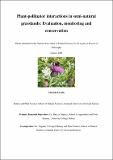| dc.contributor.advisor | Stanley, Dara A. | |
| dc.contributor.advisor | Stengel, Dagmar B. | |
| dc.contributor.author | Larkin, Michelle | |
| dc.date.accessioned | 2021-01-14T12:23:40Z | |
| dc.date.issued | 2021-01-14 | |
| dc.identifier.uri | http://hdl.handle.net/10379/16453 | |
| dc.description.abstract | Pollinators provide a vital ecosystem service by pollinating many commercial and wild plant species. Agricultural intensification is one of the main drivers of global pollinator population declines, with consequences for ecosystem stability and human-wellbeing. Semi-natural grasslands (SNGs) are an important refuge for pollinators by providing suitable floral resources. However, we are lacking crucial knowledge as to what factors affect pollinator diversity and their interactions with plants in SNGs, how they can be managed, and what role SNGs play in the ecology and monitoring of rare species. This thesis aims to address these knowledge gaps by examining the impacts of grassland management on pollinators (wild bees, hoverflies and butterflies) and their interactions with plants, and the ecology of coexisting rare and common species in SNGs in the Burren Region, Ireland. It was investigated whether pollinator communities were influenced by a locally led, results-based agri-environmental payment scheme (RBAPS), or by grassland management in the surrounding landscape. Results indicate taxon-specific responses to local and landscape management in SNGs. Therefore, schemes should consider whether a landscape scale approach is possible as this could enhance the local benefits of agri-environmental schemes for pollinators. Plant-pollinator networks were also examined to see if a RBAPS and landscape management of grasslands influenced these interactions. Identification of key plant species for bumblebees, solitary bees, hoverflies and butterflies was conducted to see if any plant species could be incorporated into an RBAPS to aid in conserving pollinators. The RBAPS and surrounding landscape influenced networks, indicating that to conserve plant-pollinator networks, management through a RBAPS should occur at both spatial scales. Taxon-specific preferences for key plant species were found, and thus these preferences should be considered when adopting conservation measures for pollinators. SNGs can also support important populations of rare species. As common and rare species coexist together in ecological communities, to develop conservation actions for rare species it is important to understand how their ecological needs compare to coexisting common species, and how to monitor populations to detect changes over time. Therefore, it was investigated whether the general ecology, and detectability of a nationally rare bumblebee, Bombus sylvarum, differed to coexisting common bumblebee species. While common bumblebees were found to be flexible in their habitat and forage usage, B. sylvarum displayed habitat and forage preferences. The level of detectability also differed between bumblebee species. SNGs are an important habitat for pollinator communities with the findings of this thesis providing valuable information that can be used to inform future developments of existing and future agri-environmental schemes and conservation strategies. | en_IE |
| dc.publisher | NUI Galway | |
| dc.rights | Attribution-NonCommercial-NoDerivs 3.0 Ireland | |
| dc.rights.uri | https://creativecommons.org/licenses/by-nc-nd/3.0/ie/ | |
| dc.subject | Bees | en_IE |
| dc.subject | Biodiversity monitoring | en_IE |
| dc.subject | Ecology | en_IE |
| dc.subject | Floral diversity | en_IE |
| dc.subject | Hoverflies | en_IE |
| dc.subject | Landscape management | en_IE |
| dc.subject | Plant-pollinator interactions | en_IE |
| dc.subject | Pollinator conservation | en_IE |
| dc.subject | Results-based agri-environmental payment scheme | en_IE |
| dc.subject | Semi-natural grassland | en_IE |
| dc.subject | Farmland biodiversity | en_IE |
| dc.subject | Rarity | en_IE |
| dc.subject | Entomology | en_IE |
| dc.subject | Science and Engineering | en_IE |
| dc.subject | Natural Sciences | en_IE |
| dc.subject | Botany | en_IE |
| dc.title | Plant-pollinator interactions in semi-natural grasslands: Evaluation, monitoring and conservation | en_IE |
| dc.type | Thesis | en |
| dc.contributor.funder | Irish Research Council for Science, Engineering and Technology | en_IE |
| dc.contributor.funder | College of Science, National University of Ireland, Galway | en_IE |
| dc.contributor.funder | Thomas Crawford Hayes Fund, National University of Ireland, Galway | en_IE |
| dc.contributor.funder | Ryan Institute, National University of Ireland Galway | en_IE |
| dc.local.note | This PhD examined the impacts of grassland management on insect pollinators (wild bees, hoverflies and butterflies) and their interactions with plants, as well as the ecology of a rare bumblebee species in semi-natural grasslands with the aim of informing and improving agri-environmental schemes and conservation strategies for pollinators | en_IE |
| dc.description.embargo | 2025-01-08 | |
| dc.local.final | Yes | en_IE |
| nui.item.downloads | 0 | |


